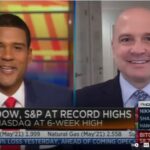
Risks to the 2019 Stock Market Rally
 As Jerry Garcia sang, “What a Long Strange Trip It’s Been.” The same might be said today of the stock market—over the past ten years of market expansion, there have been a lot of wild swings and surprises. Nevertheless, as evidenced by a very strong 2019 first-quarter performance, the bull market in stocks continues.
As Jerry Garcia sang, “What a Long Strange Trip It’s Been.” The same might be said today of the stock market—over the past ten years of market expansion, there have been a lot of wild swings and surprises. Nevertheless, as evidenced by a very strong 2019 first-quarter performance, the bull market in stocks continues.
The most recent market low occurred on December 24 of last year, when Federal Reserve Bank Chairman, Jerome Powell, hinted of higher interest rates. Fears of aggressive interest-rate hikes led the stock market to tumble almost 20% from its October 2018 peak. Many investors were left worrying they may have overspent on holiday gifts.
After this quick and severe drop, Mr. Powell dramatically changed his tune. Some pundits wondered how much the jawboning from 1600 Pennsylvania Avenue led to the change in policy. That seems unlikely given the subsequent statements by multiple Federal Reserve Bank members and Fed’s fierce desire to remain independent.
Stock investors cheered this change in tone from The Fed, and the S&P 500 index had a strong final week of 2018, followed by a 13% gain in the first quarter of 2019. For those who follow market history, every time the S&P 500 scored a gain of 10% or more in the first quarter of a year since 1935, the market managed to climb up 6% more on average for the rest of the year, with positive performance 11 of the 12 times. Another interesting statistic is that every post-mid-term election year since 1950, has been positive for stocks. So barring a precipitous drop, history is on the side of stocks—at least for another 7.5 months.
The relaxed interest-rate policy has reignited life into the longest bull market in U.S. history. Fortunately for investors, bull markets don’t die of old age. As our friends at JPMorgan are fond of saying, three things that most often create bear markets are extreme valuations, interest-rate hikes, and commodity spikes. As of now, none of these look to be a threat. But markets can quickly change, and cable news will be quick to highlight (dare I say, exaggerate) any bad news. Unfortunately, emotional reactions can be costly, as anyone who sold stocks on Boxing Day 2018 can attest.
But before we break out in a chorus of ‘Happy Days Are Here Again,’ let’s look at three warning signs that shouldn’t necessarily scare investors, but rather serve as a reminder that risks remain.
Slowing and uneven global growth. The IMF dropped growth estimates in the U.S. to 2.3% and in the Eurozone to 1.6%. It dropped energy-rich Canada’s growth estimates to 1.5%, surprising considering the rise in oil prices—but perhaps indicating another early Stanley Cup exit by the hockey teams north of the border. All references to Canada’s 26-year Lord Stanley absence aside, global growth is struggling—just ask the 10% plus Spaniards and Italians who are unemployed—triple that among Spanish and Italian ‘youth.’ It’s hard to find a catalyst for European resurgence other than lower interest rates. But with the 10-year German Bund hovering around 0%, how much lower can European interest rates go?
China’s central government intervention. The Chinese government relaxed bank reserve requirements and lowered taxes. In addition, The Bank of China is actually buying stocks (but still well behind The Bank of Japan, which is the all-time leader on this ‘strategy’). China has high debt levels, and its economy was stagnating until the government stepped in with stimulus. It seems that with the high-stakes trade talks nearing culmination, the Chinese didn’t want to appear weak. Their latest actions have helped catapult their stock market, which is actually outperforming the U.S. year-to-date. The question is what happens when government policy subsides?
Lower U.S. corporate earnings. Corporate profits are a big driver of stock prices, and U.S. companies will likely post lower earnings than in 2018. That concern is already baked into stock prices, but if the decline is bigger than expected, it could lower stock market valuations. The forward Price-to-Earnings ratio, an important indicator of stock prices relative to their estimated earnings, is close to its historical average but at the higher end of the range.
Overall, it is a mixed picture for stocks. We have accommodative central bank policies around the globe, but that is due to the sluggish economic outlook. Valuations are reasonable, but absent a catalyst for growth, it appears that the majority of 2019 gains have been realized. For investors, it might be best to evaluate their tolerance to interim market fluctuations and manage expectations.









Engage us on Facebook
Follow us on Twitter
Tweets by @mymcmedia